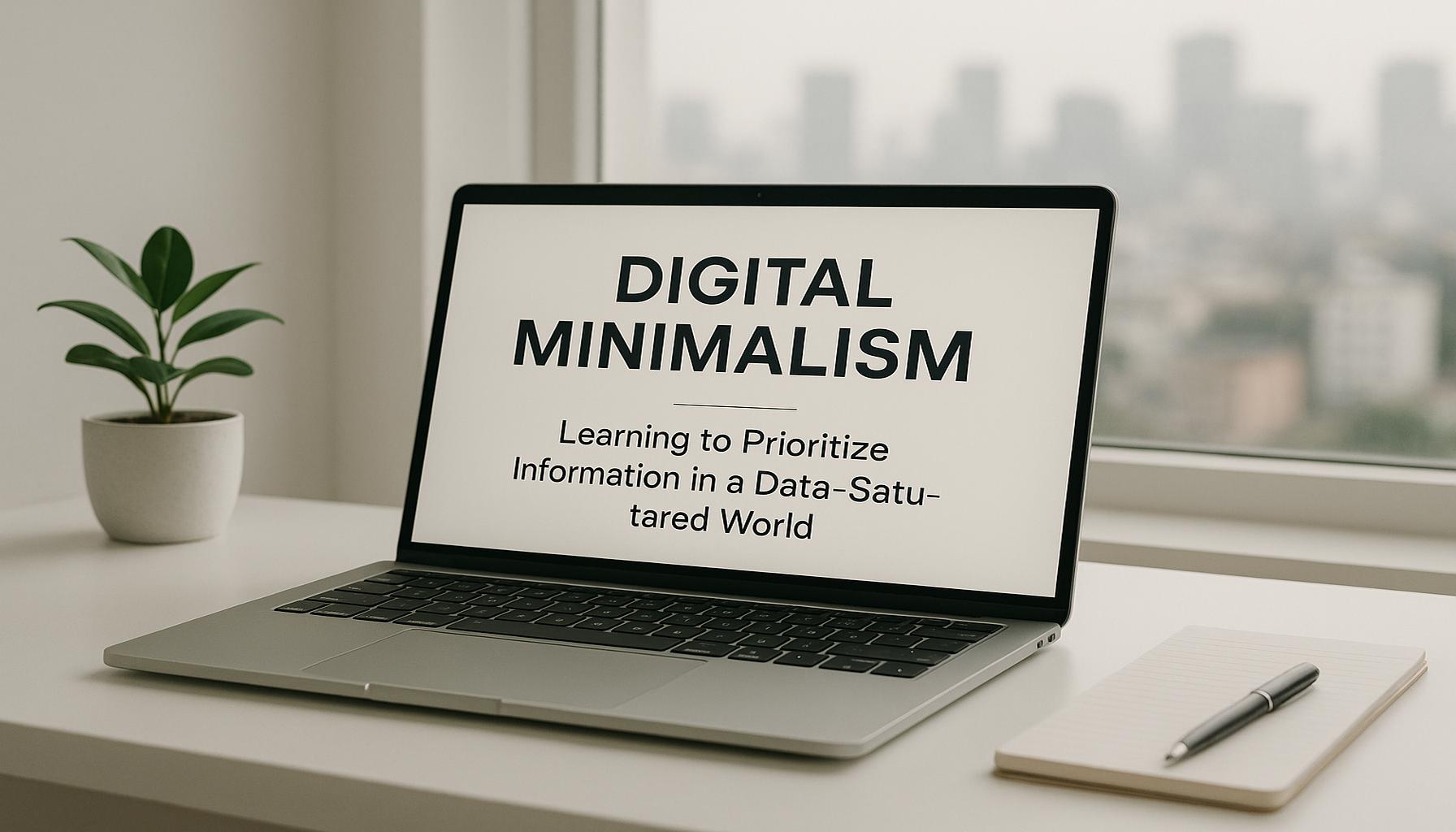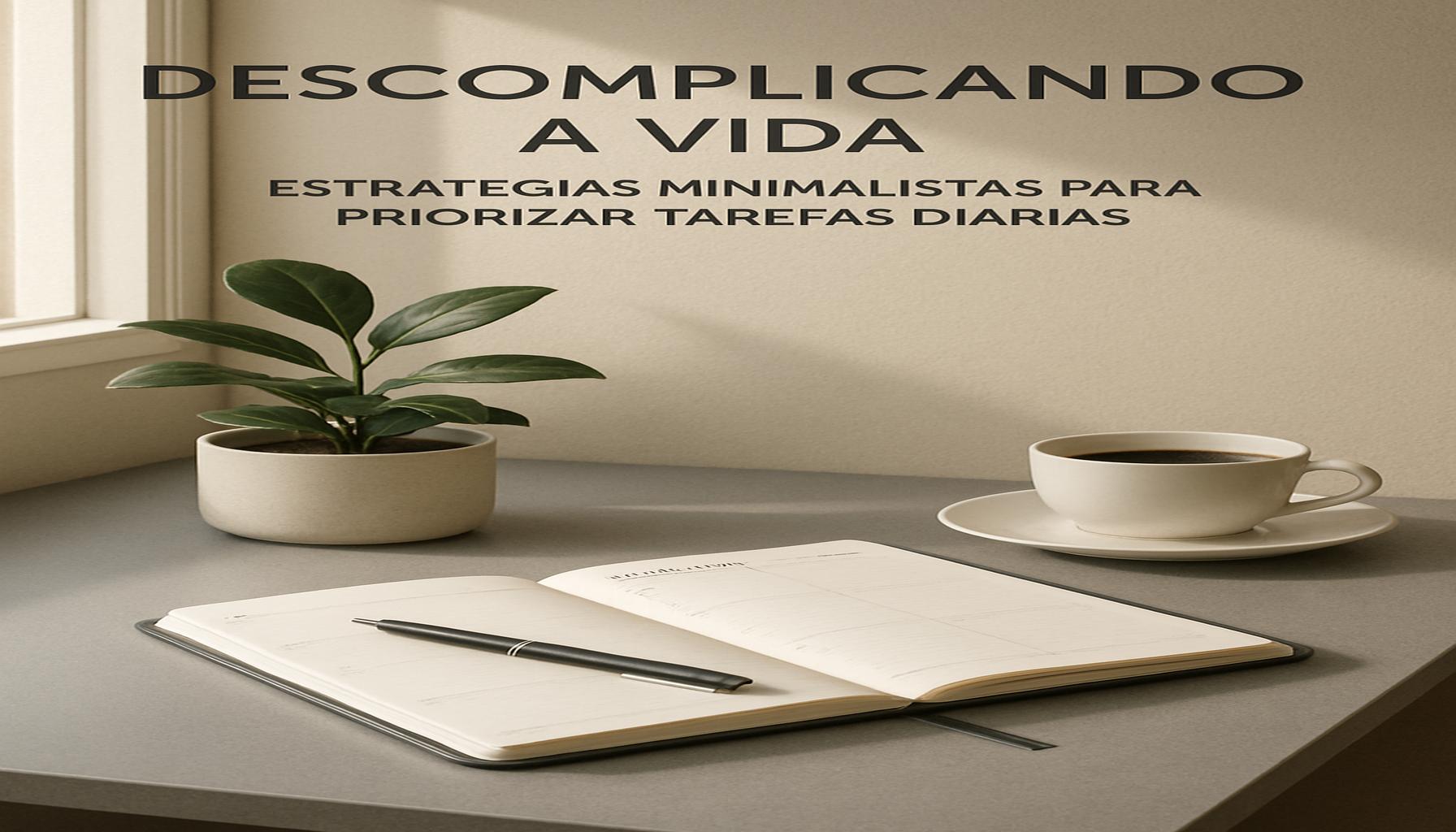Digital Minimalism: Learning to Prioritize Information in a Data-Saturated World

Understanding Digital Minimalism
In the current age, marked by relentless technological advancement and an avalanche of information, the importance of adopting a strategic approach to our digital lives cannot be overstated. The statistic that the average American consumes over 100,000 words in a day paints a vivid picture of just how saturated our daily routine has become. From notifications on smartphones to updates on social media platforms, the inundation of content is not only staggering but can also lead to significant mental strain. As a result, individuals are increasingly recognizing the detrimental effects of this constant connectivity, which can manifest as decision fatigue—the mental exhaustion that comes from making numerous decisions throughout the day—and cognitive overload, a state where the brain is overwhelmed by excessive information.
The Rise of Digital Minimalism
In response to these challenges, many individuals and professionals are exploring the concept of digital minimalism. This philosophy encourages users to intentionally and critically assess the digital information they encounter, helping them focus on what truly matters to their lives and work. By selecting only the most impactful content, practitioners can experience a profound shift in their mental clarity and overall productivity.
The key principles of digital minimalism can significantly help mitigate the chaos of digital life:
- Selective Engagement: By identifying and focusing on content that aligns with personal and professional goals, individuals can sift through the noise to uncover relevant information. For example, a professional seeking career advancement might prioritize articles related to industry trends while sidelining trivial social media updates.
- Mindful Consumption: Being intentional about the sources of information we consume can shield us from unnecessary stress. Limiting exposure to sensational news outlets or engaging in echo chambers on social media can create a more balanced and calm digital ecosystem.
- Regular Digital Detoxes: Just as our physical bodies need breaks, so do our minds. Scheduling consistent intervals away from screens, whether it’s during a weekend retreat or simply a daily hour of disconnection, allows for much-needed reflection and recharge.
The Benefits of Embracing Digital Minimalism
Adopting a minimalist mindset does not merely declutter our digital lives; it also enhances our mental well-being. Studies have shown that reducing screen time correlates with lower rates of anxiety and depression. Furthermore, improved productivity is often reported by those who implement digital minimalism, as a streamlined information flow allows for more focused and efficient work. By embracing these practices, individuals can reclaim their time, attention, and mental clarity.
As we delve further into this article, we will explore various strategies for effectively implementing digital minimalism, sharing practical tips and insights, and guiding readers on how to navigate our information-saturated world wisely. This journey toward a more intentional digital presence encourages exploration and self-discovery, empowering individuals to take control of their online experiences. Together, let’s uncover the transformative potential of digital minimalism amidst the digital chaos!
DIVE DEEPER: Click here to learn more
Practices for Implementing Digital Minimalism
As we explore the practical application of digital minimalism, it’s essential to identify actionable strategies that individuals can integrate into their daily lives. Although the concept of minimalism might seem abstract, translating it into tangible practices can make a profound difference in how we engage with the digital landscape. Here are several effective approaches to begin embracing a more intentional digital lifestyle:
- Establish Clear Goals: Before decluttering your digital environment, it is critical to understand what you want to achieve. Whether it’s enhancing productivity, cultivating creativity, or reducing stress, setting well-defined personal goals allows you to curate your digital interactions accordingly. For instance, a student aiming to improve their grades may decide to limit their social media time to focus on academic-related content.
- Audit Your Digital Footprint: Take a close look at the apps, subscriptions, and online services you currently use. Are they contributing to your goals, or are they merely occupying space on your device? Regularly assessing your digital tools can highlight areas where you can cut unnecessary clutter. You might discover that certain news apps are providing information you rarely engage with, allowing you to delete them and reduce distractions.
- Turn Off Notifications: Notifications can lead to constant interruptions, dismantling focus and engagement. By disabling non-essential alerts, individuals can regain control over their attention. Consider turning off notifications for social media platforms and limiting alerts on email applications to designated times. This practice will create a more serene digital environment, fostering deeper engagement with essential tasks.
- Create Content Curations: Instead of mindlessly scrolling through endless streams of information, consider curating a personal library of resources that align with your interests and needs. Use tools like bookmarking services or content aggregators to compile articles, podcasts, and videos that are genuinely valuable to you. This curated collection can serve as a touchstone, guiding your consumption toward quality content.
In implementing these practices, individuals may initially encounter discomfort as they navigate the transition to a minimalist approach. Measures such as limiting screen time or being selective about engagements may create a sense of withdrawal from the constant connectivity that has become second nature. However, these discomforts often pave the way for a refreshed sense of clarity and control over one’s digital life.
The Importance of Community in Digital Minimalism
Another critical aspect of embracing digital minimalism is seeking out community support. Engaging with like-minded individuals can provide motivation and accountability as you pursue your minimalist journey. Online forums and social media groups dedicated to the principles of digital minimalism offer platforms to share experiences, tips, and challenges. Moreover, discussion can lead to the discovery of new resources or further refine your understanding of what it means to prioritize information in a chaotic digital environment.
As you continue to delve into your own digital habits, understanding that digital minimalism is not just an individual endeavor is crucial. Communities built around shared goals can foster an environment where collective growth and exploration thrive. In the following sections, we will explore further techniques for refining your digital life and delve deeper into the long-term benefits of minimizing information saturation.
| Benefits of Digital Minimalism | Key Features |
|---|---|
| Enhanced Focus | Minimizing distractions allows for deeper engagement with important tasks. |
| Improved Mental Clarity | Filtering out unnecessary information clears mental bandwidth, fostering better decision-making. |
| Time Management | Digital minimalism promotes effective use of time by prioritizing quality over quantity in information consumption. |
| Stronger Relationships | Reducing digital noise allows for more meaningful interpersonal communications. |
As our world becomes increasingly saturated with digital content, the **principles of digital minimalism** emerge as a powerful tool to navigate this complexity. By adopting strategies that help prioritize what truly matters, individuals can reclaim their time and attention, leading to greater fulfillment and productivity in both personal and professional realms. Embracing this mindset not only transforms information consumption habits but also cultivates an environment where meaningful connections flourish amid the chaos of modern life.
DISCOVER MORE: Click here for effective decluttering strategies
Harnessing the Power of Intentional Consumption
In a world overflowing with information, the practice of digital minimalism extends beyond decluttering and organization; it encompasses the idea of intentional consumption. This notion places great emphasis on how we choose to engage with digital content, encouraging a more discerning approach to information intake. By adopting intentional consumption habits, individuals can effectively prioritize the information that truly matters to them.
- Practice Selective Engagement: One powerful method of intentional consumption is to be judicious about the platforms and content you engage with. Instead of passively browsing through social media feeds or news aggregators, consider dedicating specific times to interact with chosen platforms. This level of commitment allows you to be fully present in the moment. For example, allocate 30 minutes per day solely for reading informative articles or watching educational videos that directly contribute to your personal goals.
- Embrace Deep Work: Fostering the ability to focus on one task at a time is essential in a data-saturated world. Popularized by Cal Newport, the concept of deep work promotes sustained attention towards cognitively demanding tasks without distractions. Establishing designated time slots for deep work not only enhances productivity but also improves the quality of what you produce. Consider implementing deep work sessions where digital distractions are eliminated, allowing for a more profound engagement with the material at hand.
- Limit Input Sources: While the internet provides a vast array of information, too many sources can lead to confusion and overwhelm. To combat this, streamline your information ecosystem. Choose a handful of trusted sources to follow and unsubscribe from those that do not add value to your knowledge base. For instance, a person interested in technology may follow only three reputable tech blogs, rather than subscribing to countless newsletters that clog their inbox. This simplification of sources can ultimately lead to clearer insights and more meaningful connections to the content consumed.
- Incorporate Reflection Practices: Reflection plays a vital role in digital minimalism and intentional consumption. Set aside time at the end of each week to review the material you engaged with and assess its value in relation to your goals. Questions to ponder include: What content enriched my understanding? Which information felt like noise? By regularly reflecting on your digital consumption, you can fine-tune your approach, reinforcing habits that align with your aspirations.
The journey towards mastering intentional consumption is transformative, prompting individuals to develop a more conscious relationship with technology and information. Research has shown that individuals who engage mindfully with digital content experience enhanced clarity and reduced feelings of anxiety—underscoring the tangible psychological benefits of adopting digital minimalism.
The Role of Technology in Supporting Minimalism
Interestingly, technology can also aid in practicing digital minimalism. Numerous applications and tools exist to assist users in curating and managing their digital lives. Programs like Freedom and StayFocusd help block distracting websites, allowing users to remain committed to their digital goals. Furthermore, content-filtering tools like Feedly can aggregate only the most pertinent feeds, reducing irrelevant inputs and ensuring users remain focused on quality over quantity.
Incorporating these tools into one’s digital regimen allows for a more refined approach to information consumption, emphasizing quality interactions with digital content. By leveraging technology in alignment with minimalism, individuals can reclaim their focus and creativity from the chaos of the online world.
DISCOVER MORE: Click here to deepen your knowledge
Conclusion: Embracing Digital Minimalism for a Clearer Mind
In conclusion, digital minimalism serves as an essential framework for individuals navigating the complexities of a data-saturated world. As we face an incessant barrage of information, the techniques of intentional consumption become vital in helping us sift through digital noise. By practicing selective engagement, embracing deep work, limiting input sources, and incorporating reflection into our routines, we empower ourselves to prioritize what truly matters.
Furthermore, the integration of technology in our minimalist journey showcases a promising paradox: tools designed to enhance our digital lives can simultaneously help us simplify them. Whether through apps that block distractions or platforms that filter irrelevant content, technology can act as an ally in promoting clarity and focus.
Ultimately, adopting a minimalist mindset is not merely about reducing the volume of information we consume; it is about enriching our lives by cultivating a thoughtful relationship with technology. By doing so, we pave the way for enhanced creativity, reduced anxiety, and a more purposeful existence in our interconnected world. As digital minimalism gains traction, it invites us to reclaim our attention and invest it where it counts, fostering personal growth and meaningful experiences. The journey toward digital clarity awaits—are you ready to embrace it?


